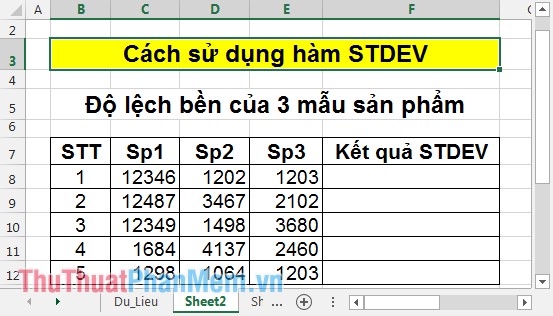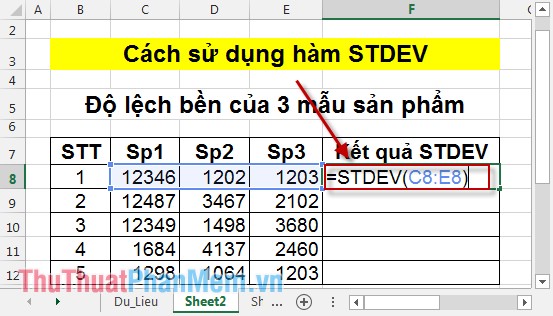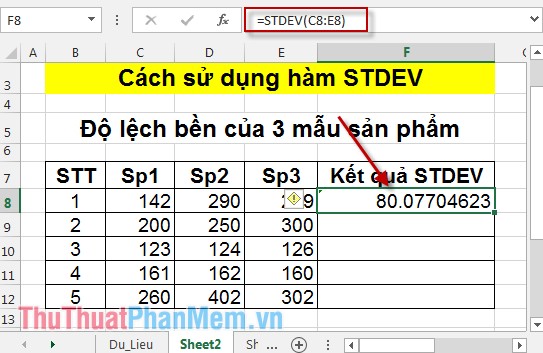STDEV function - The function of estimating standard deviations based on a sample in Excel
In the statistical probability of determining the corresponding deviation between samples is very meticulous and detailed, there is still some confusion. The following article details the STDEV function that helps you estimate the standard deviation based on an existing sample.
Description: The function helps estimate the standard deviation based on a sample, where the standard deviation is a measure of the dispersion of values compared to the average.
Syntax: STDEV (number1, [number2], .) .
Inside:
- number1: The first argument in the form of a number corresponding to the value in the overall sample, is a required parameter.
- number2 . : The second argument in the form of a number corresponding to the overall sample, is an optional parameter, the number of parameters from 2 to 255 parameters. Note if you use separate parameters you use commas to separate the number values.
--- -> You can replace individual values with a single array or refer to an array.
Attention:
- Calculation formula of STDEV function :

Inside:
+ x : is the average sample AVERAGE (number1, number2, .).
+ n : is the size of the sample.
- Where data represents the whole population => use STDEVP function to calculate standard deviation.
- Standard deviation calculation based on the method: " n-1 ".
- Value parameters can be numbers or names, arrays, or references that contain numeric values.
- The function counts arguments in the case of logical values and presents the number of textual forms directly typed into the list.
- If the parameter is an array or reference -> only numeric values in the array are counted, in addition, blank values, logical values, text . are ignored.
- The function will give an error in case the parameters are text or logical values cannot be converted to numeric types.
- In case you want logical values, text . are allowed to calculate -> use STDEVA function .
For example:
Calculate the standard deviation of the following 3 product samples:

In the cell to calculate enter the formula: = STDEV (C8: E8) to compare the durability of 3 products corresponding to the 1st value.

Press Enter to get the standard deviation result for the 3 products:

Copying the formula for the remaining values results in:

Estimate the standard deviation by 1 when the deviation between values is negligible -> the strength between the 3 products is equal.
The above is the usage and necessary notes when using the STDEV function. Hope to help you solve the problem effectively and quickly.
Good luck!
You should read it
- STDEV.P function - The function returns the standard deviation based on the whole in Excel
- VAR function - The function of estimating variance based on a sample in Excel
- STDEVPA function - The function of estimating standard deviations based on an entire population including both text and logical values in Excel
- STDEVP function - The function of calculating standard deviations in Excel
- DEVSQ function - The function returns the sum of squares of deviations of data points from the sample mean in Excel
- VAR.S function - Function that calculates variance based on a sample, ignoring logical values and text in Excel
 AMORDEGRC function - The function returns the depreciation for each accounting period in Excel
AMORDEGRC function - The function returns the depreciation for each accounting period in Excel STDEVP function - The function of calculating standard deviations in Excel
STDEVP function - The function of calculating standard deviations in Excel TDIST function - The function returns the probability of the Student distribution in Excel
TDIST function - The function returns the probability of the Student distribution in Excel Draw a bar graph with positive and negative values in Excel
Draw a bar graph with positive and negative values in Excel How to create List, Drop Down List in Excel
How to create List, Drop Down List in Excel SUBTOTAL function - The calculation function for a group in a list in Excel
SUBTOTAL function - The calculation function for a group in a list in Excel